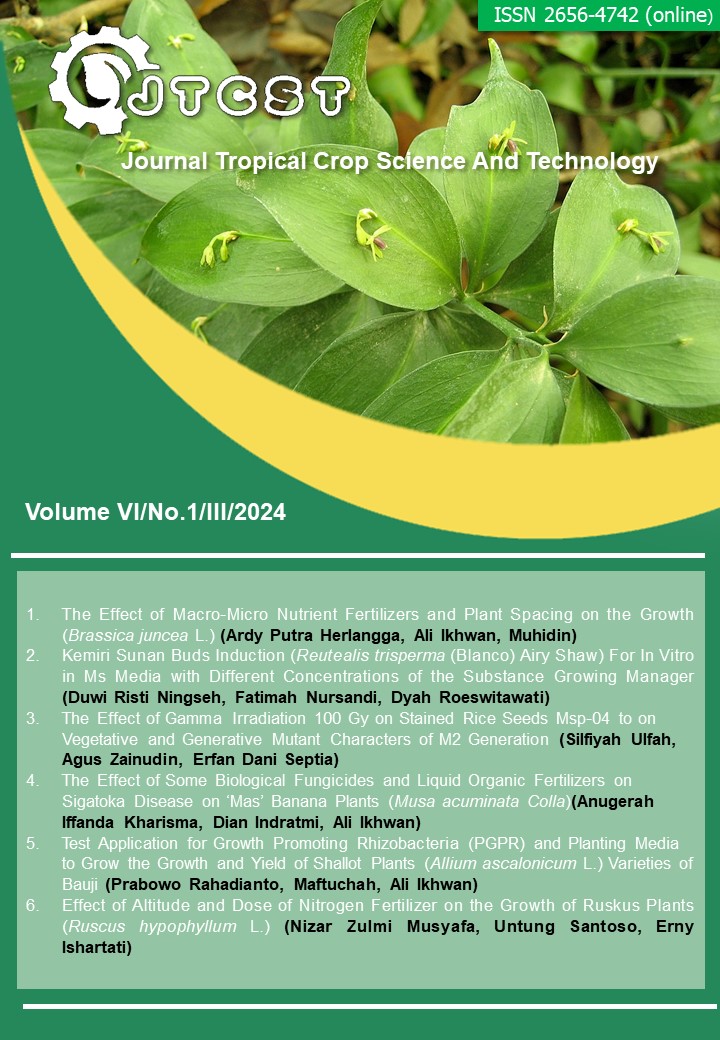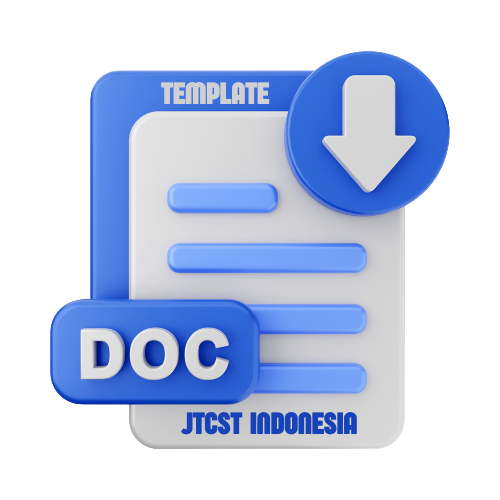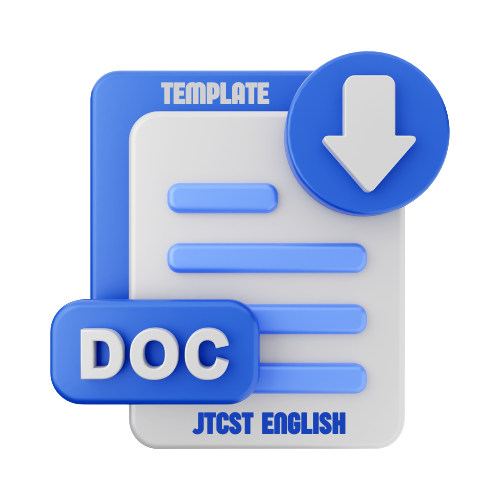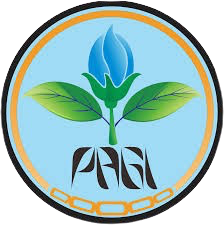The Effect of Some Biological Fungicides and Liquid Organic Fertilizers on Sigatoka Disease on ‘Mas’ Banana Plants (Musa acuminata Colla)
DOI:
https://doi.org/10.22219/jtcst.v6i2.35876Keywords:
Trichoderma sp., Sigatoka disease, Mycospharella musicolla mulderAbstract
Banana (Musa acuminata Colla) is a tropical fruit with great economic potential and export prospects. According to the Directorate General of Horticulture, Ministry of Agriculture, banana production from 2009 to 2014 fluctuated due to attacks by Plant Destruction Organisms (PDO), particularly Sigatoka disease caused by the fungus Mycosphaerella musciola. This study investigated biological agents like Trichoderma sp. and Gliocladium sp., along with liquid organic fertilizers, to control the disease without synthetic fungicides.The research, conducted at the University of Muhammadiyah Malang, used a split-plot design with two factors: biological pesticides (Tricogreen, Natural Glio, Trico-G) and liquid organic fertilizers (rabbit urine POC, shrimp shell MOL, banana hump MOL). The experiment had nine treatment combinations with three plant samples each. Results showed that biological pesticides significantly reduced Sigatoka disease intensity, with the J3P3 treatment (Trico-G and Banana Hump MOL) achieving the lowest infection rate of 29.55%, reducing disease intensity by 70.45%. Liquid organic fertilizers also improved plant growth, increasing leaf number and leaf area. This indicates that biological agents and organic fertilizers effectively manage Sigatoka disease and promote healthy banana plant growth.
Downloads
References
Aliah, N. U., L. sulistyowati dan A. Muhinnudin. 2015. Hubungan ketebalan lapisan epidermis daun terhadap serangan jamur prnyebab penyakit daun sigatoka pada sepuluh kultivar pisang. Jurnal HPT. 3(1):35-43.
Arseni, L dan A. Rofik. 2015. Inventarisasi dan identifikasi cendawan patogen pada tanaman pisang rutai (Musa borneensis). ZIRAA’AH, Volume 40 Nomor 2, Halaman 129-139.
Arseni, L. dan T. Nugrahini. 2016. Jamur Mycosphaerella musicola patogen bercak daun pada pisang rutai (Musa borneensis). ZIRAA’AH, Volume 41 Nomor 2, Halaman 285-289.
Badan Pusat Statistik (BPS). 2015. Produksi Tanaman Buah-buahan Pisang (Ton). https://www.bps.go.id. Diakses pada tanggal 25 September 2016.
Crous PW. 2009. Taxonomy and phylogeny of the genus Mycosphaerella and its anamorpoh. Fungal Diversity 38:1-24.
Goodwin, S.B., L. D. Dunkle, and V. L Zisman. 2001. Phylogenetic analysis of Cercospora and Mycosphaerellabased on the internal transcribed spacer region of ribosomal DNA. Phytopathol. 91: 648-658.
Ilyas, M. 2006. Isolasi dan identifikasi kapang pada relung rhizosfer tanaman di kawasan cagar alam gunung Mutis, Nusa Tenggara Timur. Biodeversitas 7(2): 216-220.
Lingga, P. & Marsono. 2013. Petunjuk Penggunaan Pupuk. Penerbit Swadaya : Jakarta
Mariana, Rodinah, dan I. S. Budi. 2017. Ketahanan Kultivar Pisang Lokal Kalimantan Selatan terhadap Penyakit Bercak Sigatoka (Mycosphaerella sp.). Jurnal Fitopatologi Indonesia, Volume 13, Nomor 2, Halaman 51–58.
Maulidah, N. I., Tseng, T. S., Chen, G. H., Hsieh, H. Y., Chang, S. F., & Chuang, H. W. (2021). Transcriptome analysis revealed cellular pathways associated with abiotic stress tolerance and disease resistance induced by Pseudomonas aeruginosa in banana plants. Plant Gene, 27, 100321.
Mulyani, S. M. 2008. Pupuk dan cara pemupukan. Penerbit Rineka Cipta; Jakarta.
Ploetz RC. 2007. Diseases of tropical perennial crops: challenging problems in diverse environments. Plant Dis. 91(6):644-663.
Rante, C.S., Meray, E.R.M., Kandowangko, D.S., Ratulangi, M.M., Dien, M.F. and Sembel, D.T. 2015. Aplication of Trichoderma sp. and PGPR to control disease of strawberry at Rurukan (Mahawu). Eugenia 21(1): 14-19.
Sulyanti, E., Liswarni, Y. & Indri. 2011. Inventarisasi penyakit tanaman pisang (Musa paradisiaca Linn.) berdasarkan gejala di kabupaten Tanah datar. Manggara 12 (2):49-54.
Downloads
Published
How to Cite
Issue
Section
License
Copyright (c) 2024 Anugerah Iffanda Kharisma

This work is licensed under a Creative Commons Attribution-ShareAlike 4.0 International License.
Authors who publish with this journal agree to the following terms:
- Authors retain copyright and grant the journal right of first publication with the work simultaneously licensed under a Creative Commons Attribution License that allows others to share the work with an acknowledgement of the work's authorship and initial publication in this journal.
- Authors are able to enter into separate, additional contractual arrangements for the non-exclusive distribution of the journal's published version of the work (e.g., post it to an institutional repository or publish it in a book), with an acknowledgement of its initial publication in this journal.
- Authors are permitted and encouraged to post their work online (e.g., in institutional repositories or on their website) prior to and during the submission process, as it can lead to productive exchanges, as well as earlier and greater citation of published work (See The Effect of Open Access).











